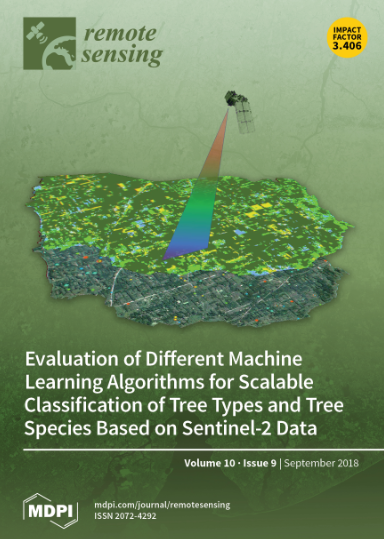卫星多光谱云检测的领域适应性
IF 4.2
2区 地球科学
Q2 ENVIRONMENTAL SCIENCES
引用次数: 0
摘要
星载机器学习硬件加速器的出现,使得利用卷积神经网络(CNN)等机器学习技术处理有效载荷数据成为可能。一个显著的例子是使用卷积神经网络检测地球观测(EO)任务捕获的多光谱数据中是否存在云层,从而只下行晴空数据以节省带宽。然而,在部署之前,采用新传感器的新任务将没有足够的代表性数据集来训练 CNN 模型,而仅根据以前任务的数据训练的模型在部署到新任务中处理数据时将表现不佳。这种表现不佳源于领域差距,即不同传感器在以前和未来任务中生成的数据的基本分布存在差异。在本文中,我们以机载多光谱云检测为背景,探讨了领域差距问题。我们的主要贡献在于根据具体的 EO 任务制定了新的域适应任务,开发了一种新的带宽高效监督域适应算法,并在空间可部署神经网络加速器上演示了测试时间适应算法。我们的贡献使我们能够调用最小的数据传输(例如,仅使用 ResNet50 中 1% 的权重)来实现域适应,从而允许在卫星上部署和更新更复杂的 CNN 模型,而不会受到域差距和带宽限制的阻碍。本文章由计算机程序翻译,如有差异,请以英文原文为准。
Domain Adaptation for Satellite-Borne Multispectral Cloud Detection
The advent of satellite-borne machine learning hardware accelerators has enabled the onboard processing of payload data using machine learning techniques such as convolutional neural networks (CNNs). A notable example is using a CNN to detect the presence of clouds in the multispectral data captured on Earth observation (EO) missions, whereby only clear sky data are downlinked to conserve bandwidth. However, prior to deployment, new missions that employ new sensors will not have enough representative datasets to train a CNN model, while a model trained solely on data from previous missions will underperform when deployed to process the data on the new missions. This underperformance stems from the domain gap, i.e., differences in the underlying distributions of the data generated by the different sensors in previous and future missions. In this paper, we address the domain gap problem in the context of onboard multispectral cloud detection. Our main contributions lie in formulating new domain adaptation tasks that are motivated by a concrete EO mission, developing a novel algorithm for bandwidth-efficient supervised domain adaptation, and demonstrating test-time adaptation algorithms on space deployable neural network accelerators. Our contributions enable minimal data transmission to be invoked (e.g., only 1% of the weights in ResNet50) to achieve domain adaptation, thereby allowing more sophisticated CNN models to be deployed and updated on satellites without being hampered by domain gap and bandwidth limitations.
求助全文
通过发布文献求助,成功后即可免费获取论文全文。
去求助
来源期刊

Remote Sensing
REMOTE SENSING-
CiteScore
8.30
自引率
24.00%
发文量
5435
审稿时长
20.66 days
期刊介绍:
Remote Sensing (ISSN 2072-4292) publishes regular research papers, reviews, letters and communications covering all aspects of the remote sensing process, from instrument design and signal processing to the retrieval of geophysical parameters and their application in geosciences. Our aim is to encourage scientists to publish experimental, theoretical and computational results in as much detail as possible so that results can be easily reproduced. There is no restriction on the length of the papers. The full experimental details must be provided so that the results can be reproduced.
 求助内容:
求助内容: 应助结果提醒方式:
应助结果提醒方式:


